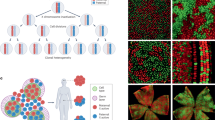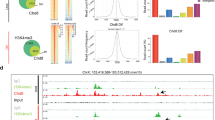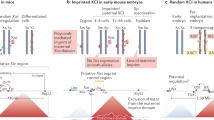Abstract
Linkage analysis was carried out in two British families with incontinentia pigmenti (IP). Both showed exclusion at several markers in Xp and proximal Xq and showed probable linkage to the DXS52 and F8C loci in Xq28. This suggests that in these families the disease locus is IP2. Using a method based on the androgen receptor gene, and confirming the results where possible at the PGK-1 and DXS255 loci, it was shown that in affected females the maternally inherited X chromosome, where it could be identified, is inactive in the majority of cells.
Similar content being viewed by others
Log in or create a free account to read this content
Gain free access to this article, as well as selected content from this journal and more on nature.com
or
References
Landy SJ, Donnai D: Incontinentia pigmenti (Bloch-Sulzberger syndrome). J Med Genet 1993;30:53–59
Carney RG: Incontinentia pigmenti. A world statistical analysis. Arch Dermatol 1976;112:535–542
Garcia-Dorado J, de Unamuno P, Fernandez-Lopez E, Salazar Veloz J, Armijo M: Incontinentia pigmenti: XXY male patient with a family history. Clin Genet 1990;38:128–138
Gorski JL, Burright EN, Harnden CE, Stein CK, Glover TW, Reyner EL: Localisation of DNA sequences to a region within Xpl 1.21 between incontinentia pigmenti (IP1) X-chromosomal breakpoints. Am J Hum Genet 1991;48:53–64
Harris A, Lakester S, Haan E: The gene for incontinenti pigmentia: Failure of linkage studies using DNA probes to confirm cytogenetic localisation. Clin Genet 1988;34: 16.
Sefiani A, Sinnett D, Abel L, et al: Linkage studies do not confirm the cytogenetic localisation of incontinenti pigmentia on Xp11. Hum Genet 1988;80:282–286
Sinnett D, Sefiani A, Lavergne L, et al: Linkage exclusion of incontinenti pigmentia locus from the short arm of X chromosome by RFLP markers. Genome 1988;30(suppl 1):233.
Sefiani A, Abel L, Heuertz S, et al: The gene for incontinenti pigmentia is assigned to Xq28. Genomics 1989;4:427–429
Sefiani A, M’rad R, Simard L, et al: Linkage relationship between incontinenti pigmentia (IP2) and nine terminal X long arm markers. Hum Genet 1991;86:297–299
Hyden-Granskog C, Salonen R, von Koskull H: Linkage studies in families with hereditary incontinenti pigmentia. Hum Genet 1993, 91:185–189.
Wieacker P, Zimmer J, Ropers HH: X inactivation patterns in two syndromes with probable X-linked dominant, male lethal inheritance. Clin Genet 1985;28:238–242
Migeon BR, Axelman J, de Beuer SJ, Valle D, Mitchell GA, Rosenbaum KN: Selection against lethal alleles in females heterozygous for incontinenti pigmentia. Am J Hum Genet 1989;44:100–106
Sambrook J, Fritsch EF, Maniatis T: Molecular Cloning: A Laboratory Manual. New York, Cold Spring Harbor Laboratory Press, 1989.
Lathrop GM, Lalouel J: Efficient computations in multilocus linkage analysis. Am J Hum Genet 1984;36:460–465
Allen RC, Zoghbi H, Moseley AM, Rossenblatt HM, Belmont JW: Methylationof Hpall and HhaI sites near the polymorphic CAG repeat in the human androgen-receptor gene correlates with X-chromosome inactivation. Am J Hum Genet 1992;51:1229–1239
Gilliland DG, Blanchard KL, Levy J, Perrin S, Bunn HF: Clonality in myeloproliferative disorders: Analysis by means of the polymerase chain reaction. Proc Natl Acad Sci USA 1991;88:6848–6852
Tilley WD, Marcelli M, Wilson JD, McPhaul MJ: Characterisation and expression of a cDNA encoding the human androgen receptor. Proc Natl Acad Sci USA 1989;86:327–331
La Spada AR, Wilson EM, Lubahn DB, Harding AE, Fischbeck KH: Androgen receptor gene mutations in X-linked spinal and bulbar muscular atrophy. Nature 1991;352:77–79
Van Kamp H, Jansen R, Willemze R, Fibbe WE, Landegent JE: Studies on clonality by PCR analysis of the PGK-1 gene. Nucleic Acids Res 1991;19:2794.
Boyd Y, Fraser NJ: Methylation patterns at the hypervariable X chromosome locus DXS255 (M27B): Correlation with X-inactivation status. Genomics 1990;7:182–187
Brown RM, Fraser NJ, Brown GK: Differential methylation of the hypervariable locus DXS255 on active and inactive X chromosomes correlates with the expression of a human X-linked gene. Genomics 1990;7:215–221
Hendriks RW, Kraakman MEM, Mensink RGJ, Schuurman RKB: Differential methylation at the 5′ and 3′ CCGG sites flanking the X chromosomal hypervariable DXS255 locus. Hum Genet 1991;88:105–111
Abrahamson G, Fraser NJ, Boyd Y, Craig I, Wainscoat JS: A highly informative X chromosome probe, M27B, can be used for the determination of tumour clonality. Br J Haematol 1990;74:371–372
Schafer R, Zischler H, Epplen JT: (CAC)5, a very informative oligonucleotide probe for DNA fingerprinting. Nucleic Acids Res 1988,16:51–69.
Nurnberg P, Roewer L, Neitzel H, Sperling K, Popperl A, Hundreiser J, Poche H, Epplen C, Zischler H, Epplen JT: DNA fingerprinting with the oligonucleotide probe (CAC)5/(GTG)5: Somatic stability and germline mutations. Hum Genet 1989;84:75–78
Ott J: Analysis of Human Genetic Linkage, rev ed. Baltimore, Johns Hopkins Press, 1991.
Harris A, Collins J, Vetrie D, Cole C, Bobrow M: X inactivation as a mechanism of selection against lethal alleles: Further investigation of incontinenti pigmentia and X-linked lymphoproliferative disease. J Med Genet 1992;29:608–614
Coleman R, Genet SA, Harper JI, Wilkie AOM: Interaction of incontinenti pigmentia and factor VIII mutations in a female with biased X inactivation, resulting in haemophilia. J Med Genet 1993;30:497–500
Hendriks RW, De Weers M, Mensink RG, et al: Diagnosis of Wiskott-Aldrich syndrome by analysis of the X chromosome inactivation patterns in maternal leukocyte populations using the hypervariable DXS255 locus. Clin Exp Immunol 1991;84:219–222
Acknowledgements
We would like to acknowledge the assistance and helpful discussions from all staff of the Molecular Genetics Unit. In particular, we would like to thank Judith Goodship for discussions regarding the study of X chromosome activity and R.C. Allen for providing a preprint of his paper. This research was funded by the Sir Jules Thorn Trust and the Wellcome Trust (Grant No. 033229/Z/91/1/1.27/DG).
Author information
Authors and Affiliations
Rights and permissions
About this article
Cite this article
Curtis, A.R.J., Lindsay, S., Boye, E. et al. A Study of X Chromosome Activity in Two Incontinentia pigmenti Families with Probable Linkage to Xq28. Eur J Hum Genet 2, 51–58 (1994). https://doi.org/10.1159/000472341
Received:
Revised:
Accepted:
Issue date:
DOI: https://doi.org/10.1159/000472341



